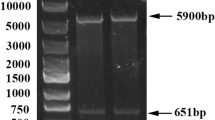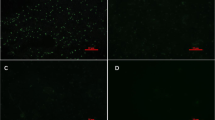Abstract
Streptococcus suis is an important zoonotic pathogen causing infections in pigs and humans. Bacterial surface-related proteins are often explored as potential vaccine candidates and diagnostic antigens. In the present study, glutamate dehydrogenase, a highly conserved immunogenic extracellular protein, was used to establish a dot horseradish peroxidase enzyme-linked staphylococcal protein A immunosorbent assay (Dot-PPA-ELISA) for diagnosis of S. suis infection. The antigen–antibody reaction was optimised through checkerboard titration involving serial dilutions, followed by selective blocking tests and evaluations of cross-reaction, repeatability, and stability. Comparative analysis by using a conventional plate ELISA kit showed that the specificity and sensitivity of the Dot-PPA-ELISA were 97.5 and 96.6%, respectively. Furthermore, dynamic changes in the levels of antibody in rabbits immunised with a propolis inactivated vaccine were monitored by Dot-PPA-ELISA. A total seroprevalence of 73.1% in 305 pig serum samples indicated the method’s applicability to detect S. suis infection. Cumulatively, the results suggested that Dot-PAA-ELISA is a convenient, rapid, sensitive, and specific diagnostic method suitable for studying large numbers of samples obtained from clinical and epidemiological studies, thereby helping reduce important economic losses.



Similar content being viewed by others
References
Bai X, Liu Z, Ji S, Ji S, Gottschalk M, Zheng H, Xu J (2015) Simultaneous detection of 33 Streptococcus suis serotypes using the luminex Xtag (R) assay. J Microbiol Methods 117:95–99
Bhattacharya D, Bhattacharya R, Dhar TK (1999) A novel signal amplification technology for ELISA based on catalyzed reporter deposition. demonstration of its applicability for measuring aflatoxin B1. J Immunol Methods 230:71–86
Choi SM, Cho BH, Choi KH, Nam TS, Kim JT, Park MS, Kim BC, Kim MK, Cho KH (2012) Meningitis caused by Streptococcus suis: case report and review of the literature. J Clin Neurol 8:79–82
Creighton TE (1984) Proteins: structures and molecular principles. W.H. Freeman & Company p, Miami, p 515
Gottschalk M, Segura M (2000) The pathogenesis of the meningitis caused by Streptococcus suis: the unresolved questions. Vet Microbiol 76:259–272
Gottschalk M, Segura M, Xu J (2007) Streptococcus suis infections in humans: the Chinese experience and the situation in North America. Anim Health Res Rev 8:29–45
Gottschalk M, Xu J, Calzas C, Segura M (2010) Streptococcus suis: a new emerging or an old neglected zoonotic pathogen? Future Microbiol 5:371–391
Goyette-Desjardins G, Auger JP, Xu J, Segura M, Gottschalk M (2014) Streptococcus suis, an important pig pathogen and emerging zoonotic agent-an update on the worldwide distribution based on serotyping and sequence typing. Emerg Microbes Infect 3:e45
Hatrongjit R, Kerdsin A, Gottschalk M, Takeuchi D, Hamada S, Oishi K, Akeda Y (2015) First human case report of sepsis due to infection with Streptococcus suis serotype 31 in Thailand. BMC Infect Dis 15:392
Hill JE, Gottschalk M, Brousseau R, Harel J, Hemmingsen SM, Goh SH (2005) Biochemical analysis, cpn60 and 16S rDNA sequence data indicate that Streptococcus suis serotypes 32 and 34, isolated from pigs, are Streptococcus orisratti. Vet Microbiol 107(1–2):63–69
Huong VT, Ha N, Huy NT, Horby P, Nghia HD, Thiem VD, Zhu X, Hoa NT, Hien TT, Zamora J, Schultsz C, Wertheim HF, Hirayama K (2014) Epidemiology, clinical manifestations, and outcomes of Streptococcus suis infection in humans. Emerg Infect Dis 20:1105–1114
Kerdsin A, Akeda Y, Hatrongjit R, Detchawna U, Sekizaki T, Hamada S, Gottschalk M, Oishi K (2014) Streptococcus suis serotyping by a new multiplex PCR. J Med Microbiol 63:824–830
Kerdsin A, Hatrongjit R, Gottschalk M, Takeuchi D, Hamada S, Akeda Y, Oishi K (2015) Emergence of Streptococcus suis serotype 9 infection in humans. J Microbiol Immunol Infect. doi:10.1016/j.jmii.2015.06.011
Lyerly DM, Barroso LA, Wilkins TD (1991) Identification of the latex test-reactive protein of clostridium difficile as glutamate dehydrogenase. J Clin Microbiol 29:2639–2642
Nakayama T, Zhao J, Takeuchi D, Kerdsind A, Chiranairadule P, Areeratanaf P, Loetthongf P, Pienpringamf A, Akedac Y, Oishig K (2014) Colloidal gold-based immunochromatographic strip test compromising optimised combinations of anti-S. suis capsular polysaccharide polyclonal antibodies for detection of Streptococcus suis. Biosens Bioelectron 60:175–179
Ndao M (2009) Diagnosis of parasitic diseases: old and new approaches. Interdiscip Perspect Infect Dis 2009:278246
Nomoto R, Maruyama F, Ishida S, Tohya M, Sekizaki T, Osawa R (2015) Reappraisal of the taxonomy of Streptococcus suis serotypes 20, 22 and 26: Streptococcus parasuis sp. nov. Int J Syst Evol Microbiol 65:438–443
Okwumabua O, Persaud JS, Reddy PG (2001) Cloning and characterization of the gene encoding the glutamate dehydrogenase of Streptococcus suis serotype 2. Clin Diagn Lab Immunol 8:251–257
Okwumabua O, O’Connor M, Shull E (2003) A polymerase chain reaction (PCR) assay specific for Streptococcus suis based on the gene encoding the glutamate dehydrogenase. FEMS Microbiol Lett 218:79–84
Sonowal S, Barua AG, Hazarika RA, Rajkhowa S, Barua CC, Bhattacharya K (2014) Detection of glutamate dehydrogenase gene (gdh) in Streptococcus suis isolated from pigs. Indian J Anim Sci 84:287–288
Srinivasan V, McGee L, Njanpop-Lafourcade B, Moïsi J, Beall B (2016) Species-specific real-time PCR assay for the detection of Streptococcus suis from clinical specimens. Diagn Micr Infec Dis 85:131–132
Staats JJ, Feder I, Okwumabua O, Chengappa MM (1997) Streptococcus suis: past and present. Vet Res Commun 21:381–407
Tien LH, Nishibori T, Nishitani Y, Nomoto R, Osawa R (2013) Reappraisal of the taxonomy of Streptococcus suis serotypes 20, 22, 26, and 33 based on DNA-DNA homology and sodA and recN phylogenies. Vet Microbiol 162:842–849
Wang Z, Yu D, Li X, Zeng M, Chen Z, Bi L, Liu J, Jin L, Hu D, Yang S, Song B (2012) The development and application of a Dot-ELISA assay for diagnosis of southern rice black-streaked dwarf disease in the field. Viruses 4:167–183
Wertheim HF, Nghia HD, Taylor W, Schultsz C (2009) Streptococcus suis: an emerging human pathogen. Clin Infect Dis 48:617–625
Xia X, Shen Z, Jiang S, Li S, Wu L, Ma Z, Cheng L (2011) Prokaryotic expression of gene encoding glutamate dehydrogenase of Streptococcus suis Serotype 2 and preparation of polyclonal antibodies against its expressed products. Anim Husb Feed Sci 3:15–19
Zhang J, Zhu J, Ren H, Zhu S, Zhao P, Zhang F, Lv H, Hu D, Hao L, Geng M, Gong X, Pan X, Wang C, Qi Z (2013) Rapid visual detection of highly pathogenic Streptococcus suis serotype 2 isolates by use of loop-mediated isothermal amplification. J Clin Microbiol 51:3250–3256
Zheng W, Zhang R, Wu X, Ren Y, Nong X, Gu X, Wang S, Peng X, Yang G (2014) Evaluating troponin C from Psoroptes cuniculi as a diagnostic antigen for a Dot-ELISA assay to diagnose mite infestations in rabbits. Parasite Immunol 36:53–59
Zhu Q, Chai Y, Zhuo Y, Yuan R (2015) An amperometric immunosensor for detection of Streptococcus suis serotype 2 using a nickel-gold nanocomposite as a tracer matrix. RSC ADV 5:79323–79328
Author information
Authors and Affiliations
Corresponding authors
Electronic supplementary material
Below is the link to the electronic supplementary material.
10482_2016_825_MOESM1_ESM.tif
Supplementary material 1 (TIFF 1288 kb) Supplementary Fig. 1. Optimised concentration of antibody and antigen of the Indirect Dot-PPA-ELISA. Rows for sera of twofold dilutions from 1:10 to 1:2560, Row 10 for the control; lanes for the antigen of twofold dilutions from 0.3 µg/ml to 20 µg/ml, lane 8 for the control
10482_2016_825_MOESM2_ESM.tif
Supplementary material 2 (TIFF 1305 kb) Supplementary Fig. 2. Evaluation of assay repeatability of the Indirect Dot-PPA-ELISA. (a) Five positive serum samples were selected for intra-assay repeatability, three replicates of the same serum sample were performed in the same sheet. (b) Five positive serum samples were selected for inter-assay repeatability, three replicates of each sample were run in different sheets on different occasions.(c) Five batches of the rGDH protein were purified and used for coating antigen, three replicates of each batched were run in same sheets on same occasions
10482_2016_825_MOESM3_ESM.tif
Supplementary material 3 (TIFF 539 kb) Evaluation of assay stability of the Indirect Dot-PPA-ELISA. The coated NC sheet were stored at −20, 4, 25 or 37 °C for 1-6 month, and subsequently were used for the Indirect Dot-PPA-ELISA detection
Rights and permissions
About this article
Cite this article
Xia, Xj., Wang, L., Shen, Zq. et al. Development of an Indirect Dot-PPA-ELISA using glutamate dehydrogenase as a diagnostic antigen for the rapid and specific detection of Streptococcus suis and its application to clinical specimens. Antonie van Leeuwenhoek 110, 585–592 (2017). https://doi.org/10.1007/s10482-016-0825-z
Received:
Accepted:
Published:
Issue Date:
DOI: https://doi.org/10.1007/s10482-016-0825-z




